Prediction Wizard Dialogs
Wizard Basics
Starting Wizard
To open the prediction wizard:
- Click Prediction icon in Data Discovery/Analytics ribbon.
- Select Advanced Prediction command.

Wizard Tips
It is recommended to fill the various dialogs in order. However, you are free to navigate freely between the various dialogs and make changes as needed.
- Use the navigation panel on the left (Welcome, Algorithm, etc.) to switch between dialogs.
- In order to create a predictive model, you are required to specify at least one input item (category or number).
- When you have completed filling the Final dialog, click OK to create a wizard template and a predictive model.
Wizard Dialogs
This wizard contains the following interactive dialogs (which are described below).
- Welcome
- Algorithm
- What to Predict
- Items to Predict For
- Categories to Predict By
- Numbers to Predict By
- R Script
- Final
Welcome
When you open the wizard, the Welcome dialog is displayed. When you are ready to proceed, click on Algorithm.
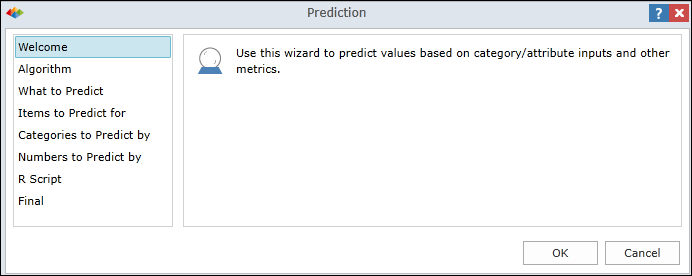
Algorithm
The Algorithm dialog allows you to specify several parameters which determine how the predictive model will operate. See the descriptions below.
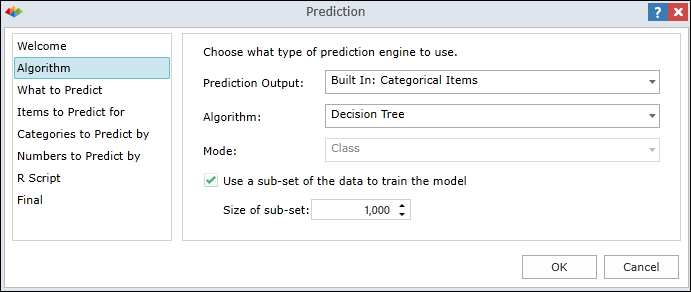
Prediction Output
Select one of the following:
- Built-In Categorical Items - Starts the process of designing a predictive model. The "What to Predict" dialog will request a dimension and an attribute hierarchy.
- Built-In Numeric Items - Starts the process of designing a predictive model. The "What to Predict" dialog will request a measure.
- Custom Design - The custom wizard templates that you have already saved are displayed in blue. Select a wizard template to run it on the full data set of the currently loaded model. The wizard template generates a temporary predictive model that runs on the full data set of the currently loaded model. The temporary predictive model will not be saved.
- Predictive Model (fit) - The predictive models that you have designed are displayed in green. Select a predictive model to run it on the full data set of the currently loaded model.
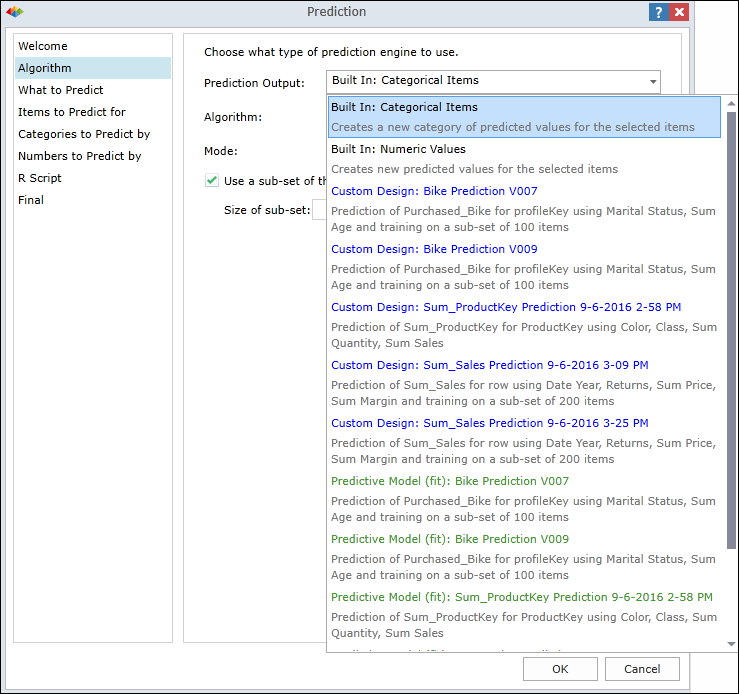
Algorithm
- Decision Tree - A tree model with its nodes representing input features. The new input is examined by the tree and is routed to the right leaf which is labeled as the result prediction.
- Neural Net - A network of connections with weights that examines the input to find the closest result to the data it was trained on.
Use a Subset
You can limit the size of the data sub-set used by the wizard for training the predictive model. For example, if your data includes 40,000 items, you might use an initial sub-set of 2,000 items to pre-train the predictive model. Once you are satisfied with the overall results, you can (optionally) retrain the predictive model with a larger subset or with the full data set.
NOTE: Using a sub-set will allow the wizard to produce a predictive model much quicker, but the results will usually be less accurate.
What to Predict
Use this dialog to select an attribute hierarchy or measurement which you wish to predict. This value serves as the X input for the wizard template in building the predictive model. When the predictive model is run, it will generate the X item for the data set on which it is being run.
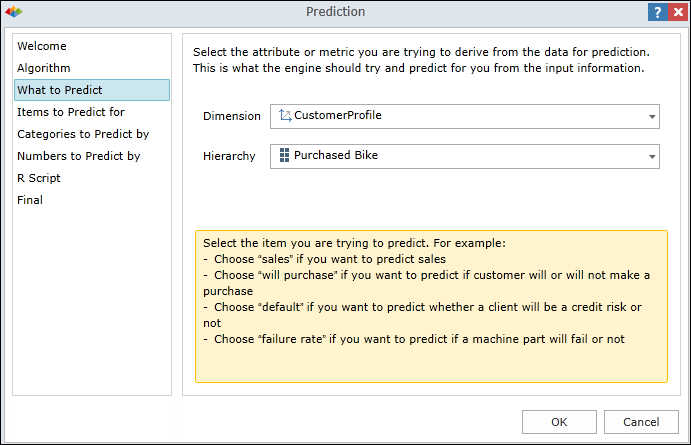
The content of this dialog depends on the choice you made above for Prediction Output.
| Prediction Output: | Fields displayed in dialog: |
|---|---|
|
Built-In Categorical Items
|
Dimension Hierarchy |
|
Built-In Numeric Items
|
Metric
|
Items to Predict For
In this dialog, you need to select a unique number/value/string that can be used to identify the target of the prediction. Some examples might include a unique customer ID, a unique transaction number, or a unique machine part. Using the customer name would be a bad choice since two people often have the exact same name.
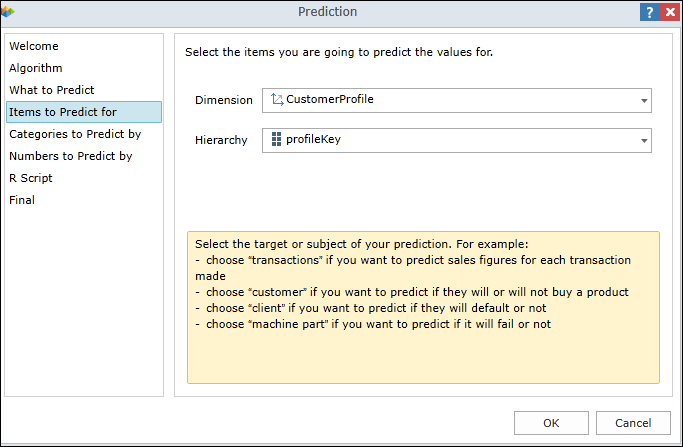
Categories to Predict By
In this dialog, you select one or more categories (attribute hierarchies) that will be used as input for the building of the predictive model.
The six-pack icon  indicates that the hierarchy is an attribute hierarchy, meaning it's a flat data structure containing a single data level.
indicates that the hierarchy is an attribute hierarchy, meaning it's a flat data structure containing a single data level.
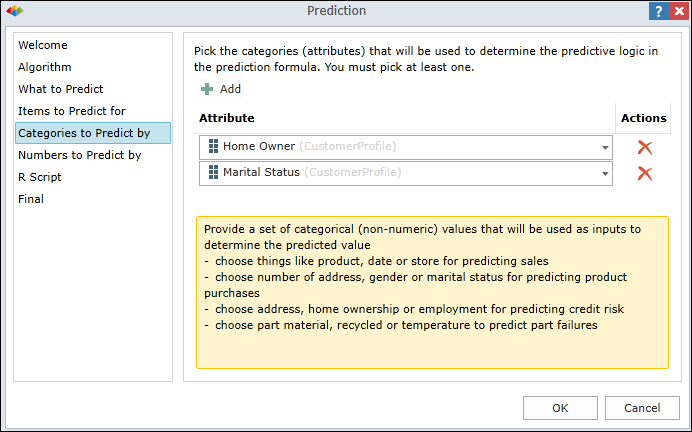
Numbers to Predict By
In this dialog, you can select one or more measures that will be used as input for the building of the predictive model.
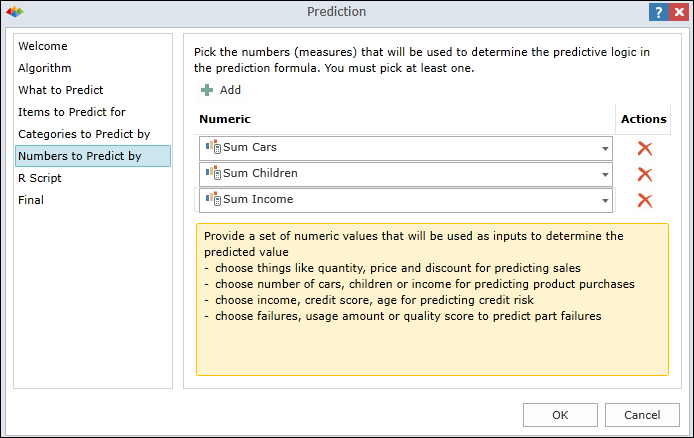
R Script
For most BI Office users, the R Script dialog can be skipped. For advanced users, it's possible to edit the R Script in Manual Mode.
Automatic Mode
By default, the "Customize Script" box is unchecked and the wizard interactively generates an R Script based on your current wizard selections. If you make changes to your wizard selections, the R Script is instantly updated.
Manual Mode
If you check the "Customize Script" box, the R Script is disconnected from the prediction wizard. The R Script enters manual mode "as is" and will no longer be updated automatically. At this point, you may edit the R Script and the predictive model will be generated based on your custom R Script.
If you later uncheck the box, you return to Automatic Mode and the R Script will be instantly changed to match your current wizard selections. Your manual changes will be lost. If you wish to preserve your changes, be sure to create a duplicate copy of the wizard template or copy/paste your R Script into an external editor such as Notepad.
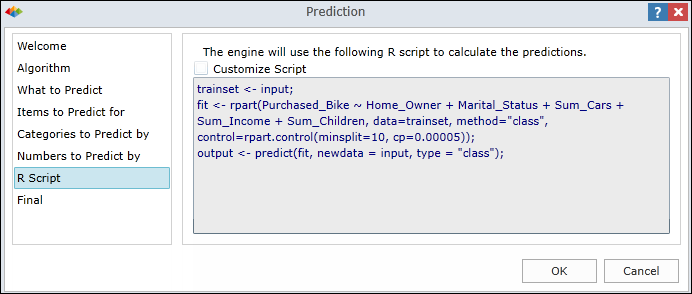
Final
In the Final dialog you can select output options and then click OK to generate a wizard template and predictive model.
Caption - This caption (name) is used to create both the wizard template and the predictive model. A default name is supplied, based on your current wizard selections. The name can be used "as is", edited or replaced.
Description - A default description is supplied, based on your current wizard selections. The description can be used "as is", edited or replaced.
Save predictive model - Check this box if you wish to save the predictive model for future usage. The predictive model can be used with any report that is based on the same data model. It can also be used with a report based on a different data model, provided the model contains the EXACT same element names (cap sensitive) on which the predictive model is based (dimension, hierarchies, measures, etc.).
Save design - Check this box to save the wizard template for future usage. The wizard template can be used with any report that is based on the same data model.
Save as a new version - By default, this box is unchecked and the system prevents you from saving the wizard template with an existing name. If checked, you can save the wizard template with an existing name and the system will create an additional version of the template.
NOTE: You cannot save the wizard template with an existing name if you have already created a predictive model with the same name (you would need to first delete the predictive model).
Access - Select Private or Public to specify security rights for accessing the wizard template and the predictive model.
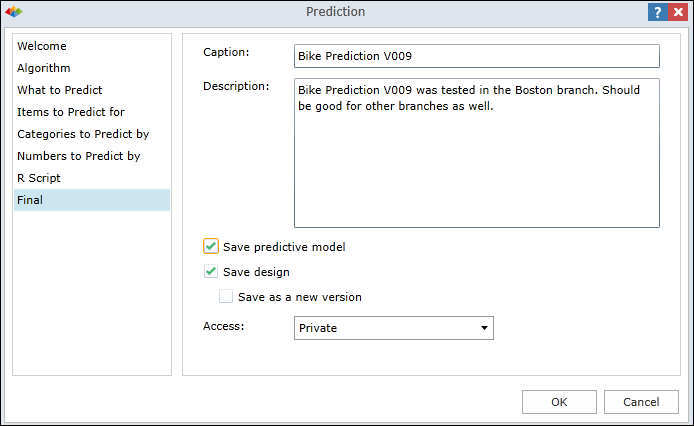
See Also
Home |
Table of Contents |
Index |
User Community
Pyramid Analytics © 2011-2022

